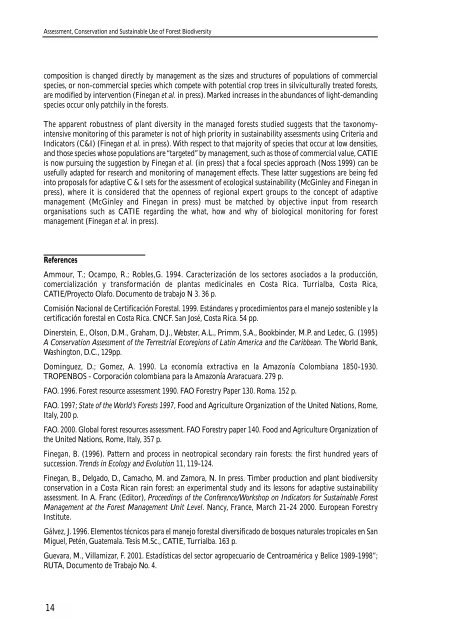Assessment, Conservation and Sustainable Use of Forest Biodiversity
Assessment, Conservation and Sustainable Use of Forest Biodiversity
Assessment, Conservation and Sustainable Use of Forest Biodiversity
Create successful ePaper yourself
Turn your PDF publications into a flip-book with our unique Google optimized e-Paper software.
<strong>Assessment</strong>, <strong>Conservation</strong> <strong>and</strong> <strong>Sustainable</strong> <strong>Use</strong> <strong>of</strong> <strong>Forest</strong> <strong>Biodiversity</strong><br />
composition is changed directly by management as the sizes <strong>and</strong> structures <strong>of</strong> populations <strong>of</strong> commercial<br />
species, or non-commercial species which compete with potential crop trees in silviculturally treated forests,<br />
are modified by intervention (Finegan et al. in press). Marked increases in the abundances <strong>of</strong> light-dem<strong>and</strong>ing<br />
species occur only patchily in the forests.<br />
The apparent robustness <strong>of</strong> plant diversity in the managed forests studied suggests that the taxonomyintensive<br />
monitoring <strong>of</strong> this parameter is not <strong>of</strong> high priority in sustainability assessments using Criteria <strong>and</strong><br />
Indicators (C&I) (Finegan et al. in press). With respect to that majority <strong>of</strong> species that occur at low densities,<br />
<strong>and</strong> those species whose populations are “targeted” by management, such as those <strong>of</strong> commercial value, CATIE<br />
is now pursuing the suggestion by Finegan et al. (in press) that a focal species approach (Noss 1999) can be<br />
usefully adapted for research <strong>and</strong> monitoring <strong>of</strong> management effects. These latter suggestions are being fed<br />
into proposals for adaptive C & I sets for the assessment <strong>of</strong> ecological sustainability (McGinley <strong>and</strong> Finegan in<br />
press), where it is considered that the openness <strong>of</strong> regional expert groups to the concept <strong>of</strong> adaptive<br />
management (McGinley <strong>and</strong> Finegan in press) must be matched by objective input from research<br />
organisations such as CATIE regarding the what, how <strong>and</strong> why <strong>of</strong> biological monitoring for forest<br />
management (Finegan et al. in press).<br />
References<br />
Ammour, T.; Ocampo, R.; Robles,G. 1994. Caracterización de los sectores asociados a la producción,<br />
comercialización y transformación de plantas medicinales en Costa Rica. Turrialba, Costa Rica,<br />
CATIE/Proyecto Olafo. Documento de trabajo N 3. 36 p.<br />
Comisión Nacional de Certificación <strong>Forest</strong>al. 1999. Estándares y procedimientos para el manejo sostenible y la<br />
certificación forestal en Costa Rica. CNCF. San José, Costa Rica. 54 pp.<br />
Dinerstein, E., Olson, D.M., Graham, D.J., Webster, A.L., Primm, S.A., Bookbinder, M.P. <strong>and</strong> Ledec, G. (1995)<br />
A <strong>Conservation</strong> <strong>Assessment</strong> <strong>of</strong> the Terrestrial Ecoregions <strong>of</strong> Latin America <strong>and</strong> the Caribbean. The World Bank,<br />
Washington, D.C., 129pp.<br />
Dominguez, D.; Gomez, A. 1990. La economía extractiva en la Amazonía Colombiana 1850-1930.<br />
TROPENBOS - Corporación colombiana para la Amazonía Araracuara. 279 p.<br />
FAO. 1996. <strong>Forest</strong> resource assessment 1990. FAO <strong>Forest</strong>ry Paper 130. Roma. 152 p.<br />
FAO. 1997; State <strong>of</strong> the World’s <strong>Forest</strong>s 1997, Food <strong>and</strong> Agriculture Organization <strong>of</strong> the United Nations, Rome,<br />
Italy, 200 p.<br />
FAO. 2000. Global forest resources assessment. FAO <strong>Forest</strong>ry paper 140. Food <strong>and</strong> Agriculture Organization <strong>of</strong><br />
the United Nations, Rome, Italy, 357 p.<br />
Finegan, B. (1996). Pattern <strong>and</strong> process in neotropical secondary rain forests: the first hundred years <strong>of</strong><br />
succession. Trends in Ecology <strong>and</strong> Evolution 11, 119-124.<br />
Finegan, B., Delgado, D., Camacho, M. <strong>and</strong> Zamora, N. In press. Timber production <strong>and</strong> plant biodiversity<br />
conservation in a Costa Rican rain forest: an experimental study <strong>and</strong> its lessons for adaptive sustainability<br />
assessment. In A. Franc (Editor), Proceedings <strong>of</strong> the Conference/Workshop on Indicators for <strong>Sustainable</strong> <strong>Forest</strong><br />
Management at the <strong>Forest</strong> Management Unit Level. Nancy, France, March 21-24 2000. European <strong>Forest</strong>ry<br />
Institute.<br />
Gálvez, J. 1996. Elementos técnicos para el manejo forestal diversificado de bosques naturales tropicales en San<br />
Miguel, Petén, Guatemala. Tesis M.Sc., CATIE, Turrialba. 163 p.<br />
Guevara, M., Villamizar, F. 2001. Estadísticas del sector agropecuario de Centroamérica y Belice 1989-1998”;<br />
RUTA, Documento de Trabajo No. 4.<br />
14

















